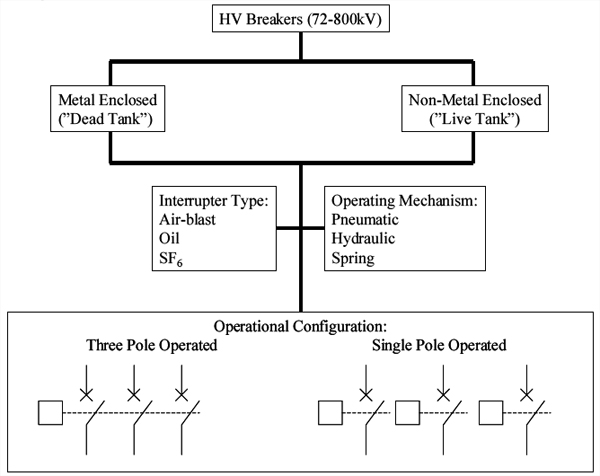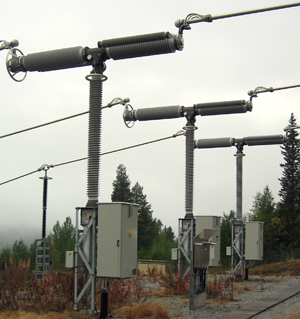| Circuit
breakers and SF6 |
|
|
|
Circuit breakers are used in High voltage
DC and AC applications for swithcing of powerlines,
transformers, reactors and capacitors. One phase and
three phase operations up to 800kV, 63kA. |
|
There is a wide
variety of HV circuit breaker designs and configurations
in existence. They can be classified in various ways,
but the most common classifications are described in the
figure below. |
A circuit breaker has several main functions:
• Conduct rated currents when closed
• Maintain rated insulation withstand across its contacts when open
• Close its circuit always and only on command
• Open or interrupt its circuit always and only on command, according to
its ratings |
| |
|
|
 |
| From
air-blast and oil to SF6 and springs |
|
|
|
From a historical
perspective oil and air-blast interrupters are the
oldest designs and essentially have been superceded by
SF6 interrupters since the mid-1980’s. There has also
been an increasing trend towards the use of spring
operating mechanisms from the early 1990’s, following
from the results of the second CIGRÉ enquiry into the
reliability of HV breakers. |
|
Service and testing of
circuit breakers evolve arround the electrical and
mechanical functions in order to ensure a secure and
steady elcetrical power flow. Non working breakers is an
expensive event for utilities, power companies and
manufacturers. As you can see in the conclusions below
the criterias for analysing the SF6 gas is obvious. |
| |
|
|
|
CIGRÉ report 13-202
draws some important general conclusions regarding the
most common problems with breakers, including:
• Operating mechanisms are the sub-assembly with the
most failures – further work was suggested to “simplify
the electrical and mechanical control process”.
• While only 7% of major failures in SF6 breakers were
attributed to loss of gas, approximately 40% of minor
failures were due to this problem, leading to the
conclusion that additional effort was needed (in the
early 1990’s) to address SF6 gas pole sealing and
monitoring.
• Additional type testing for mechanical endurance,
climate testing and life cycle assessment were
recommended (see later discussion on impacts on
revisions to IEC breaker standards).
• Encouragement was made for the use of “common
definitions for reliability studies and maintenance
techniques”.
|
|
Environment |
|
|
|
The need for testing of the sf6 gas is
not only to protect the electric power equipment but
maybe more importantly in order to protect our
environment A high productive
circuit breaker factory for live tank air insulated
breakers consumes approximately 50 tons of SF6 gas each
year. A deadtank circuit breaker factory consumes 10
times that amount.
A single live tank air insulated circuit breaker
contains somewhere from e few kilos up to a few tens of
kilos. While a Deadtank breaker as stated previously
consists of tens times as much. |
|
And as you may all be aware, a GIS substation can
contain several tons of Sulphur Hexaflouride.
Even though the sf6 insulated switchgear development has
managed to produce compact designs that reduces space
reduction up to 98% compared to air insulated switchgear
and has reduced the SF6 volume up to 75% with leakage
rates down to 0,5% per comparttment and year.
Air
insulated breakers is still considered to be the best
choice for our environment. |
| |
| |
|

Air insulated breaker (HPL) |